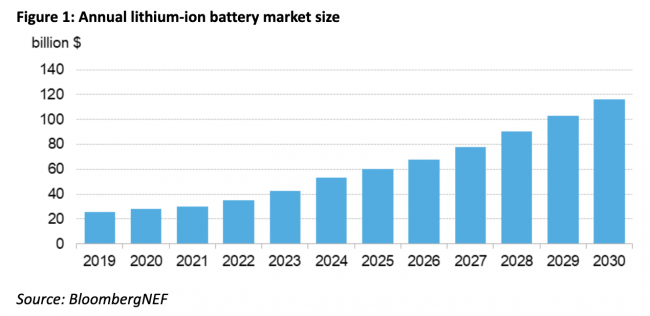BNEF’s 2019 Battery Price Survey forecasts that the average price for battery energy storage will be close to $100/kWh by 2023, down from $156/kWh this year.
This follows an 87% price drop since 2010 when prices were about $1,100/kWh in real terms.
A combination of factors continue to drive down costs: new pack designs, falling manufacturing costs, order size, growth in battery electric vehicle sales and the continued penetration of high energy density cathodes.
Falling prices and expanding market share go hand in hand in BNEF’s analysis, which finds cumulative demand for energy storage batteries reaching 2 TWh in 2024.
“According to our forecasts, by 2030 the battery market will be worth $116 billion annually, and this doesn’t include investment in the supply chain,” said James Frith, BNEF’s senior energy storage analyst and author of the report.
The falling prices bode well for electrification efforts, especially in transportation. Around 2024 battery energy storage prices will be so low that electric vehicles will start to reach price parity with conventional vehicles in some regions, according to BNEF.
Into the 2020s, prices will continue to decline as manufacturing becomes less expensive, new pack designs are introduced and supply chains change.
“Factory costs are falling thanks to improvements in manufacturing equipment and increased energy density at the cathode and cell level. The expansion of existing facilities also offers companies a lower-cost route to expand capacity,” said Logan Goldie-Scot, head of energy storage at BNEF.

While BNEF describes a clear path to $100/kWh, the research organization says the way ahead is murkier to get prices down to $61/kWh by 2030. The problem? There are many paths the industry can pursue at that point, but it’s uncertain which will dominate.